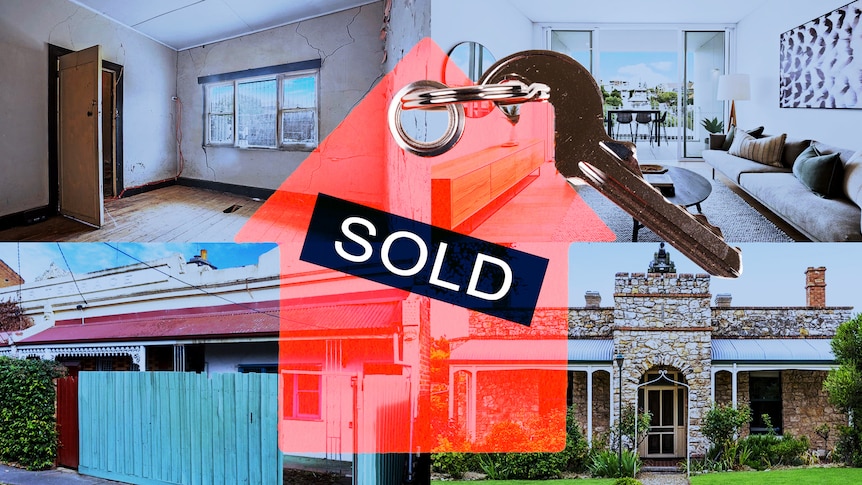House prices in Australia are dropping at their fastest pace since the global financial crisis — and market conditions are “likely to worsen” as interest rates continue to rise, according to property analytics firm CoreLogic.
Key points:
- Economists predict Australian house prices could fall between 12 and 20 per cent
- The median property value dropped 8.5pc during the GFC
- Rents have arisen 9.8pc in the past year
The latest data shows that the nation’s median property value has dropped by 2 per cent since the beginning of May, to $747,182 (a figure which includes houses and apartments).
“Although the housing market is only three months into a decline … the rate of decline is comparable with the onset of the global financial crisis (GFC) in 2008, and the sharp downswing of the early 1980s,” said CoreLogic’s research director Tim Lawless.
But he noted that, on average, prices had jumped 28.6 per cent from mid-2020 (the low point of the housing market during the COVID-19 pandemic) to April 2022 (when national prices hit their peak).
Regional Australia had an even bigger surge, with prices up 41.1 per cent in two years — as smaller towns outside the capital cities experienced a huge influx of city-dwellers seeking better lifestyles (as working remotely became the new normal).
“In Sydney, where the downturn has been particularly accelerated, we are seeing the sharpest value falls in almost 40 years.”
The median price in Australia’s most expensive city fell by 2.2 per cent in July (taking its quarterly loss to 4.7 per cent). Despite that, an average house in Sydney still costs around $1.35 million, while an average unit may fetch about $806,000.
Melbourne and Hobart also recorded steep falls, with prices in both cities down 1.5 per cent last month, while Canberra prices dropped 1.1 per cent.
Prices in Brisbane and regional Australia fell 0.8 per cent (their first monthly decline since August 2020).
At the other end of the spectrum, Darwin, Adelaide and Perth were the only capitals where prices actually went up in July (by between 0.2 and 0.4 per cent). However, it has been a sharp slowdown since May, when the Reserve Bank began to aggressively lift the cash rate from its record low levels.
short and sharp
“I think this downturn will be similar to the global financial crisis in that it will be quite short and sharp,” Mr Lawless told ABC News.
Australia’s median property price fell by around 8.5 per cent over an 11-month period during the GFC, according to CoreLogic.
Mr Lawless said the property downturn is “accelerating”, and that he would not be surprised if “the current decline gets worse than what we saw during the GFC”.
He noted the main difference is that governments and central banks are currently determined to withdraw trillions of dollars worth of stimulus, in a desperate bid to lower inflation (instead of pumping it into the global economy, liked they did after the 2008 crisis).
Many analysts are predicting Australian property prices, on average, will fall between 10 and 20 per cent (from peak to trough) — with the two most expensive cities Sydney and Melbourne likely to suffer the biggest declines.
But even if the worse case scenario eventuates, it will not drastically improve housing affordability.
“If we saw say, a 15 per cent drop in national housing values, it would take prices back to where they were in about April 2021.”
How quickly (and by how much) prices fall will depend on how aggressively the RBA decides to lift its cash rate target in the next few months.
Since May, the RBA has lifted its cash rate target from 0.1 to 1.35 per cent.
If the central bank delivers another double-sized rate hike on Tuesday (0.5 percentage points), as widely expected, that would bring the new cash rate up to 1.85 per cent.
Buyers’ market and surging rents
“The market has moved to being very much more in favor of buyers over sellers now, especially in markets like Sydney and Melbourne,” Mr Lawless said.
“Buyers are getting back in the driver’s seat. They have more choice, and there’s less urgency.
“But for sellers, it means they need to be much more realistic about their pricing expectations, and they should expect there’s going to be more negotiation.”
Renters are also disadvantaged in the current property market. As their landlords’ mortgage repayments increase (and more foreign workers and students) return to Australia, rents have surged rapidly.
“Rental markets are extremely tight, with vacancy rates around 1 per cent or lower across many parts of Australia,” Mr Lawless added.
“If you consider the history of rents, it’s very rare to see dwelling rents rising at more than say 3 – 4 per cent per annum.”
But in the past quarter, the national average rent jumped 2.8 per cent — and they are up nearly 10 per cent in the past year.
Looking forward, Mr Lawless said renters may be under increasing pressure to rent out any spare bedrooms to more flatmates, look for cheaper rents in apartments (rather than houses), or “stay at home with mum and dad longer.”
“There’s definitely going to be some negative social outcomes from such high rents, which aren’t showing any signs of slowing down at the moment.”
.
